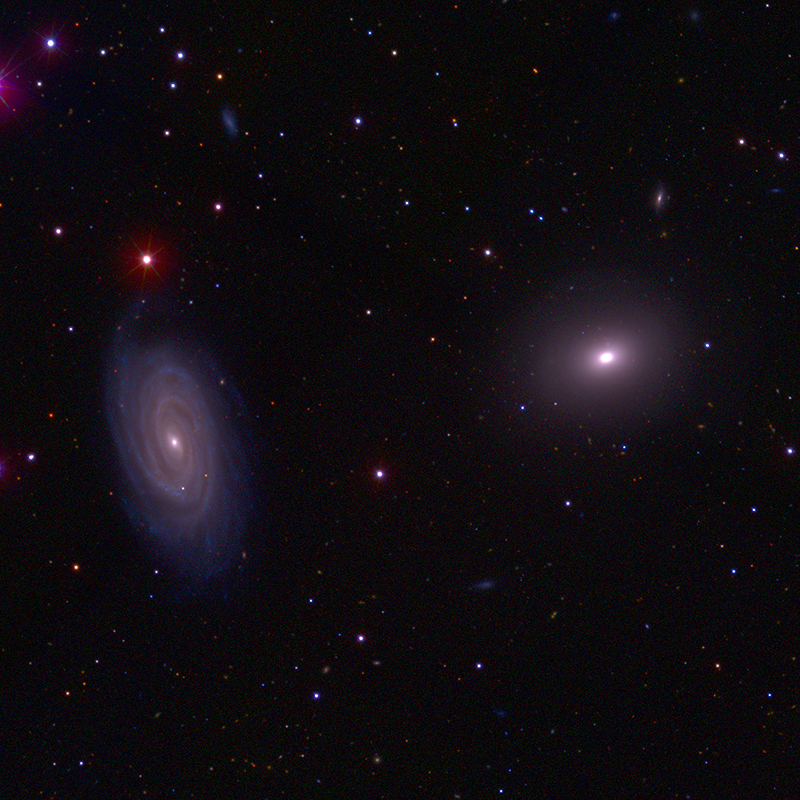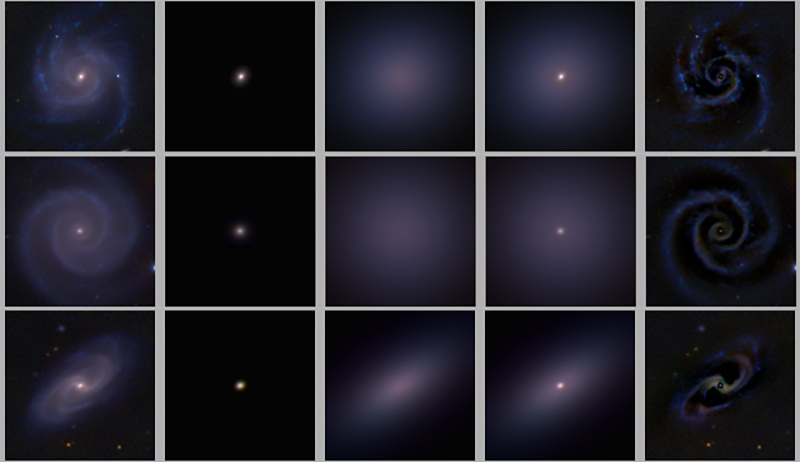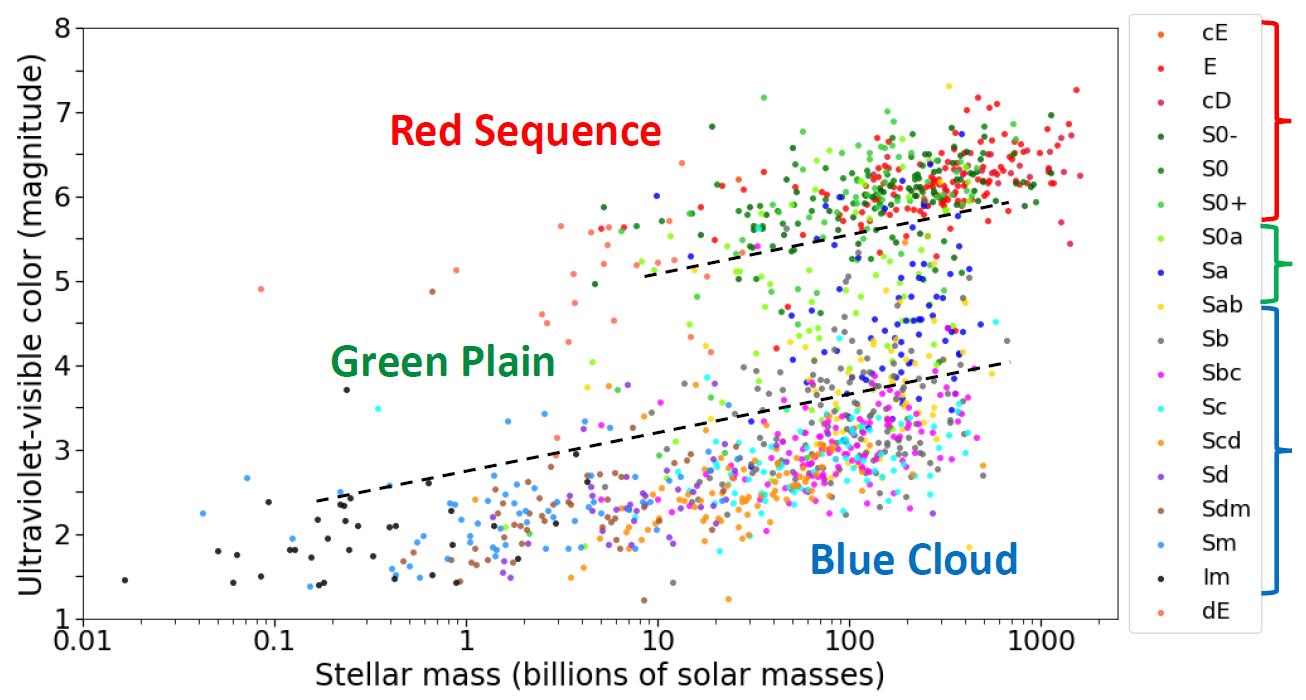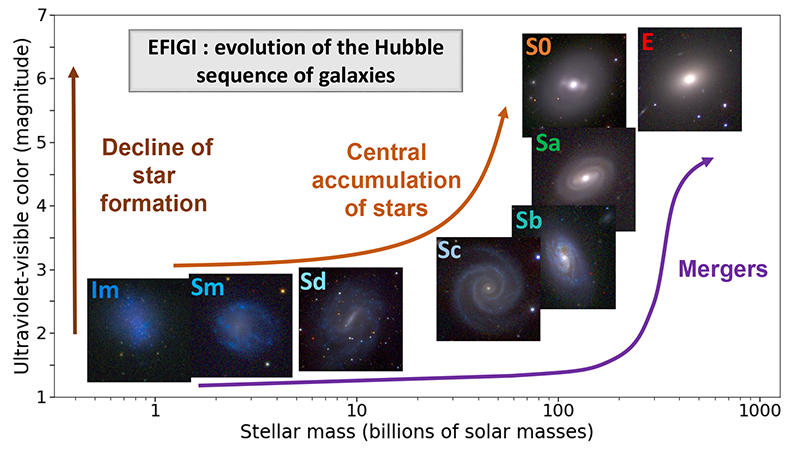THE CHANGING FACES OF GALAXIES: WHAT THEIR MORPHOLOGIES TELL US ABOUT THEIR EVOLUTION OVER COSMIC TIME
The major morphological classes of galaxies have fascinated astronomers since their discovery. A new analysis carried out by a doctoral student (Sorbonne University) and a researcher from the IAP establishes a physical link between the order of the various types of the famous Hubble sequence, and the systematic evolution of galaxies. This analysis shows for the first time that the path of galaxies across the Green Plain, the transition zone across which galaxies evolve from forming many new stars to a quiescent state, is tightly related to the morphological types, making the Hubble sequence an inverse evolutionary sequence. These results are published on October 27, 2022 in Astronomy and Astrophysics.
In 1926, the American astronomer Edwin Hubble published a morphological classification of galaxies which grouped the different objects he had observed according to their shape and the details they contained. An ordering was chosen and constituted a sequence ranging from elliptical galaxies, to lenticular, spiral and irregular galaxies (see Figure 1). Later enriched by Gérard de Vaucouleurs and Allan Sandage, the Hubble sequence remains a reference tool for classifying galaxies, still used today by astronomers. At the time, astronomers wondered if this sequence of types reflected the evolutionary stage of galaxies. At the end of the century, numerical simulations showed that the first galaxies along the sequence, the ellipticals, could be the result of mergers of spiral galaxies, located further along the sequence (see Figure 2, left panel). Such a merger between Andromeda and the Milky Way is predicted, and was recently modeled (“Xenakis, crossed views on the Andromeda galaxy”).
 Figure 1: The Hubble-de Vaucouleurs sequence illutrated by the EFIGI galaxes. It starts from left with the elliptical galaxies (E). The lower arm first contains the lenticular galaxies (S0), with a bulge and a disk, but no spiral arms. Then the spiral galaxies have a bulge of decreasing prominence, a disk and spiral arms more loosely wound as one moves to the right of the sequence, from types Sa to Sm. The upper arm shows the same types as the lower one, but with a bar across the bulge. The irregular galaxies (Im) end the sequence, with no bulge nor spiral arms. Not part of the sequence, the dwarf elliptical galaxies (dE) are added to the right.
Figure 1: The Hubble-de Vaucouleurs sequence illutrated by the EFIGI galaxes. It starts from left with the elliptical galaxies (E). The lower arm first contains the lenticular galaxies (S0), with a bulge and a disk, but no spiral arms. Then the spiral galaxies have a bulge of decreasing prominence, a disk and spiral arms more loosely wound as one moves to the right of the sequence, from types Sa to Sm. The upper arm shows the same types as the lower one, but with a bar across the bulge. The irregular galaxies (Im) end the sequence, with no bulge nor spiral arms. Not part of the sequence, the dwarf elliptical galaxies (dE) are added to the right.
Credits: Valérie de Lapparent, Sloan Digital Sky Survey, AstrOmatic.net.
A recent study of the morphology of galaxies, conducted as part of the thesis research of Louis Quilley at the Institut d’Astrophysique de Paris (IAP, a laboratory of CNRS and Sorbonne Université in France), supervised by an astrophysicist from CNRS, Valerie de Lapparent, now provides a decisive answer. This work establishes that the Hubble sequence is an inverted sequence of the evolution of galaxies. To obtain this result, the astrophysicists used the EFIGI catalog (“Extraction de Formes Idéalisés de Galaxies en Imagerie”, for “Extraction of idealized shapes of galaxies in imaging”) of 4458 nearby galaxies, whose visual classification, led by astronomers from the IAP, was published in 2011. This classification used the Sloan Digital Sky Survey (SDSS) images and benefited from the wealth of details they provide for nearby galaxies. The new analysis also exploited the SourceXtractor++ software, developed for the Euclid space telescope (planned for launch in 2023), which makes it possible to measure with reliability and precision the distribution of light inside each galaxy. These measurements in the optical domain were complemented by data obtained in the ultraviolet by the Galaxy Evolution Explorer (GALEX) space telescope, in order to calculate colors of the galaxies suited to evaluate at what rate they form stars. Finally, the Z-PEG software based on the PÉGASE.2 theoretical evolution scenarios of galaxies, all developed at the IAP, were used to estimate the mass of each galaxy.
 |
 |
Figure 2 - Left panel: The spiral galaxy NGC5985 (left) and the elliptical galaxy NGC5982 (right) in the Draco constellation, illustrating the major morphological transformation that occurs when two spiral galaxies merge and become one elliptical galaxy. Such a merger is predicted between Andromeda and the Milky Way (“Xenakis, crossed views on the Andromeda galaxy”).
Right panel: Bulge and disk modeling of three EFIGI galaxies (left), illustrated (from left to right) by the bulge model alone, the disk model alone, the sum of the two previous models, and the residual image (subtraction between the data image on the left, and the sum of the two models), showing the spiral arms and central bars, that are not modeled.
Credits: Valérie de Lapparent, Sloan Digital Sky Survey, AstrOmatic.net.
Studies of large samples of SDSS galaxies had shown a bimodal distribution of galaxy colors, separating galaxies forming new stars, gathered in the “Blue Cloud”, from the quiescent ones, that form no or very few new stars, grouped in the “Red Sequence” (see Figure 3). The strength of the new study is to show that Hubble types continuously differ in color and mass along this bimodal distribution. This effect results from the growth of the central part of the galaxies called the bulge, and from the change of color of their outer part with the shape of a disk, in which new stars are formed. These variations in the properties of bulges and disks are measured precisely by modeling them with simple shapes (see Figure 2, right panel).
 Figure 3: Distribution in color and mass of stars of the EFIGI galaxies. Each points shows a galaxy and its morphological type, as well as it location within the Red Sequence, the Green Plain and the Blue Cloud. One can see the continuous change of morphological type from the tip of the Blue Cloud, and along it, through the Green Plain, and to the Red Sequence. During mergers, that produce more and more massive galaxies (from left to right), or when they form fewer new stars (from bottom to top), the Hubble type generally becomes earlier (up in the list from right; to the left in Figure 1). Compact ellipticals (cE) and giant diffuse galaxies (cD) are rare types.
Figure 3: Distribution in color and mass of stars of the EFIGI galaxies. Each points shows a galaxy and its morphological type, as well as it location within the Red Sequence, the Green Plain and the Blue Cloud. One can see the continuous change of morphological type from the tip of the Blue Cloud, and along it, through the Green Plain, and to the Red Sequence. During mergers, that produce more and more massive galaxies (from left to right), or when they form fewer new stars (from bottom to top), the Hubble type generally becomes earlier (up in the list from right; to the left in Figure 1). Compact ellipticals (cE) and giant diffuse galaxies (cD) are rare types.
Credits: Louis Quilley, Valérie de Lapparent, Sloan Digital Sky Survey, AstrOmatic.net.
Figure 3 shows that the least massive galaxies, and which form new stars most intensively, are the irregular galaxies, of which the Magellanic Clouds are parts. These galaxies are the bluest known, due to the many newly formed hot stars they contain. The study provides evidence that they are transformed by successive mergers into increasingly massive spiral galaxies, in the center of which a bulge forms. Indeed, spiral galaxies have well-formed bulges which are rather red in color due to the mostly old stars they contain, while many new stars are formed in their disks, hence the blue color of the latter. These objects make up the Blue Cloud of galaxies forming new stars in the bimodal distribution. Our galaxy the Milky Way (the galaxy within which the Sun and the Earth are located) belongs to this region, as well as its neighbor the Andromeda Galaxy.
In addition, this analysis allows the astrophysicists to study in detail the transition zone in the bimodality, that is in between the Blue Cloud and the Red Sequence. This zone was originally called “Green Valley”, but it is renamed here “Green Plain”, as it spans a wide range of colors intermediate between blue and red (color between 3.7 and 5.7 in Figure 3). The most massive spiral galaxies are shown to pass through the Green Plain as their bulge continues to grow, while the disks form fewer and fewer stars and consequently redden, for the old stars become dominant compared to the young stars. The evolution of galaxies through the Green Plain leads to lenticular galaxies, which form few or no new stars in their disks and are as massive as the most massive spirals (but with even larger bulges). It also leads to elliptical galaxies, among which are the most massive galaxies. The formation of the latter is therefore done by successive mergers, either of massive spiral galaxies, or of lenticulars, or of other ellipticals (see Figure 3).
 Figure 4: Distribution in color and mass of stars of the morphological types of galaxies, that evolve mainly from left to right and from bottom to top: from the irregulars (Im), via the spirals (Sd, Sc, Sb, Sa), to lenticular (S0) and elliptical (E). Over time, the increase in mass (from left to right) resulting from mergers, as well as the decrease in forming new stars (from bottom to top), are accompagnied by an accumulation of stars in the center of galaxies. The Milky Way, our galaxy, is of intermediate type between Sb and Sc, and its neighboring galaxy Andromeda is of type Sb. Credits: Louis Quilley, Valérie de Lapparent, Sloan Digital Sky Survey, AstrOmatic.net.
Figure 4: Distribution in color and mass of stars of the morphological types of galaxies, that evolve mainly from left to right and from bottom to top: from the irregulars (Im), via the spirals (Sd, Sc, Sb, Sa), to lenticular (S0) and elliptical (E). Over time, the increase in mass (from left to right) resulting from mergers, as well as the decrease in forming new stars (from bottom to top), are accompagnied by an accumulation of stars in the center of galaxies. The Milky Way, our galaxy, is of intermediate type between Sb and Sc, and its neighboring galaxy Andromeda is of type Sb. Credits: Louis Quilley, Valérie de Lapparent, Sloan Digital Sky Survey, AstrOmatic.net.
This analysis therefore shows for the first time that the entire Hubble sequence is an inverse evolutionary sequence: galaxies evolve from irregular to spirals and then to lenticular and elliptical galaxies (see Figure 4). A galaxy can only evolve through the sequence backwards, but without necessarily going through all the types it contains (about fifteen). Galaxy mergers play a major role in this scenario, by explaining the huge increase in mass - by a factor of 10,000 - between irregulars and ellipticals, as well as the transformation of their morphologies, and in particular the accumulation of stars at the center of spiral and lenticular galaxies, doubling the mass of their bulges.
The color and morphology transformations are most intense at galaxy masses on the order of 100 billion masses of the Sun, when the galaxies cross the Green Plain. These changes can only occur together over long astronomical time scales, of the order of a billion years or more, probably as a result of mergers with less massive galaxies. This analysis therefore rules out models of galaxies that stop to make new stars over short timescales (of the order of a hundred million years), as it is the case for the feedback of supermassive black holes on the galaxies at the center of which they are located.
The causes of the decrease in star formation remain one of the great questions in the evolution of galaxies: do these galaxies form fewer stars because the supply of intergalactic gas decreases, or because the transformation of gas into stars is prevented? Part of the answer may be provided by new analyses of galaxies in the present time, as these new results demonstrate that these objects can provide crucial information on how morphological types were formed over cosmic time. These scenarios will have to be confronted with the very deep surveys of galaxies of the past, obtained with the James Webb Space Telescope (JWST) and the Euclid space mission, in order to obtain a coherent historical fresco. Regarding the future of the Universe, the new study indicates that all galaxies will become massive ellipticals after successive mergers, and star formation in the Universe will continue its inexorable decline, that began ten billion years ago.
Links
![]() Article in Astronomy and Astrophysics: L. Quilley, V. de Lapparent, 2022, “Aging of galaxies along the morphological sequence, marked by bulge growth and disk quenching” (Public version)
Article in Astronomy and Astrophysics: L. Quilley, V. de Lapparent, 2022, “Aging of galaxies along the morphological sequence, marked by bulge growth and disk quenching” (Public version)
![]() News of INSU/CNRS, scientific result in the theme “Universe” (in French), October 27, 2022 : “Les multiples visages des galaxies actuelles : leurs morphologies racontent leur évolution”
News of INSU/CNRS, scientific result in the theme “Universe” (in French), October 27, 2022 : “Les multiples visages des galaxies actuelles : leurs morphologies racontent leur évolution”
![]() News of Sorbonne Université, in the theme “research” from the faculty of Sciences and Engineering (in French), October 31, 2022 : “Les multiples visages des galaxies actuelles : leurs morphologies racontent leur évolution”
News of Sorbonne Université, in the theme “research” from the faculty of Sciences and Engineering (in French), October 31, 2022 : “Les multiples visages des galaxies actuelles : leurs morphologies racontent leur évolution”
![]() Podcast of France Culture in “Le Journal des Sciences” (in French), science and research news, November 7, 2022 : “Les morphologies des galaxies racontent leur évolution”
Podcast of France Culture in “Le Journal des Sciences” (in French), science and research news, November 7, 2022 : “Les morphologies des galaxies racontent leur évolution”
Writing and contacts
- Louis Quilley
Institut d’astrophysique de Paris, CNRS, Sorbonne Université
louis.quilley [at] iap [dot] fr - Valérie de Lapparent
Institut d’astrophysique de Paris, CNRS, Sorbonne Université
valerie.de_lapparent [at] iap [dot] fr
Layout and iconography: Jean Mouette, Valérie de Lapparent
October 2022
